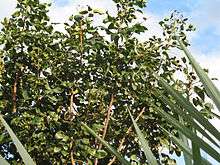Amyris
| Amyris | |
|---|---|
 | |
| Sea Torchwood (A. elemifera) | |
| Scientific classification | |
| Kingdom: | Plantae |
| (unranked): | Angiosperms |
| (unranked): | Eudicots |
| (unranked): | Rosids |
| Order: | Sapindales |
| Family: | Rutaceae |
| Subfamily: | Toddalioideae |
| Genus: | Amyris P.Browne |
| Type species | |
| Amyris balsamifera L.[1] | |
| Species | |
|
See text. | |
Amyris is a genus of flowering plants in the citrus family, Rutaceae.[2] The generic name is derived from the Greek word αμυρων (amyron), which means "intensely scented" and refers to the strong odor of the resin.[3] Members of the genus are commonly known as Torchwoods[4] because of their highly flammable wood.[5]
Uses
The trunks of Amyris species exude elemi, a type of balsam (oleoresin)
contains elemic acids, liquid sesquiterpenes, and triterpenes such as α- and β-amyrin among other components.[6] It is used medicinally and in lacquers. The wood is often used for torches and firewood. Its high resin content causes it to burn brightly, and it will burn well even when green. In addition, the wood is hard, heavy, close-grained, can take a high polish, and repels dry wood termites. Essential oils containing caryophyllene, cadinene, and cadinol are extracted from A. balsamifera and A. elemifera. These are used in varnishes, perfumes, medicines, cosmetics, soaps, and incense.[5]
Chemical compounds known as chromenylated amides isolated from Amyris plumieri have shown some inhibition of the cytochrome P450 enzymes.[7]
Selected species
- Amyris balsamifera L. – Balsam Torchwood
- Amyris diatrypa Spreng. – Hairy Torchwood
- Amyris elemifera L. – Sea Torchwood (Florida, the Caribbean, Central America)
- Amyris madrensis S.Watson – Mountain Torchwood
- Amyris polymorpha Urb. (Cuba)
- Amyris texana (Buckley) P.Wilson – Texas Torchwood, Chapotillo[4][8][9]
Formerly placed here
- Atalantia simplicifolia (Roxb.) Engl. (as A. simplicifolia Roxb.)
- Boswellia papyrifera (Delile ex Caill.) Hochst. (as A. papyrifera Delile ex Caill.)
- Canarium zeylanicum (Retz.) Blume (as A. zeylanica Retz.)
- Clausena anisata (Willd.) Hook.f. (as A. anisata Willd. or A. dentata Willd.)
- Clausena heptaphylla (Roxb. ex DC.) Wight & Arn. ex Steud. (as A. heptaphylla Roxb. ex DC.)
- Commiphora gileadensis (L.) C.Chr. (as A. gileadensis L. or A. opobalsamum L.)
- Commiphora kataf (Forssk.) Engl. (as A. kataf Forssk.)
- Metopium toxiferum (L.) Krug & Urb. (as A. toxifera L.)
- Schinus polygama (Cav.) Cabrera (as A. polygama Cav.)[8]
References
| Wikispecies has information related to: Amyris |
| Wikimedia Commons has media related to Amyris. |
- ↑ "Amyris P. Browne". TROPICOS. Missouri Botanical Garden. Retrieved 2009-12-28.
- ↑ "Genus: Amyris P. Browne". Germplasm Resources Information Network. United States Department of Agriculture. 2008-03-21. Retrieved 2009-11-30.
- ↑ Quattrocchi, Umberto (2000). CRC World Dictionary of Plant Names. I: A-C. CRC Press. p. 126. ISBN 978-0-8493-2675-2.
- 1 2 "Amyris". Integrated Taxonomic Information System. Retrieved 2010-02-22.
- 1 2 Austin, Daniel F. (2004). Florida Ethnobotany. CRC Press. pp. 88–91. ISBN 978-0-8493-2332-4.
- ↑ Langenheim, Jean H. (2003). Plant Resins: Chemistry, Evolution, Ecology, and Ethnobotany. Timber Press. pp. 356–358. ISBN 978-0-88192-574-6.
- ↑ Badal, S; Williams, SA; Huang, G; Francis, S; Vendantam, P; Dunbar, O; Jacobs, H; Tzeng, TJ; et al. (2011). "Cytochrome P450 1 enzyme inhibition and anticancer potential of chromene amides from Amyris plumieri". Fitoterapia. 82 (2): 230–6. doi:10.1016/j.fitote.2010.10.003. PMID 20951188.
- 1 2 "GRIN Species Records of Amyris". Germplasm Resources Information Network. United States Department of Agriculture. Retrieved 2010-09-16.
- ↑ "Subordinate Taxa of Amyris P. Browne". TROPICOS. Missouri Botanical Garden. Retrieved 2009-12-28.
External links
- "Amyris P. Br. torchwood". The PLANTS Database. United States Department of Agriculture.